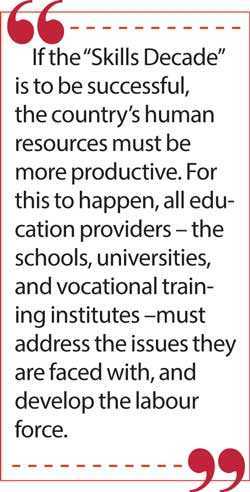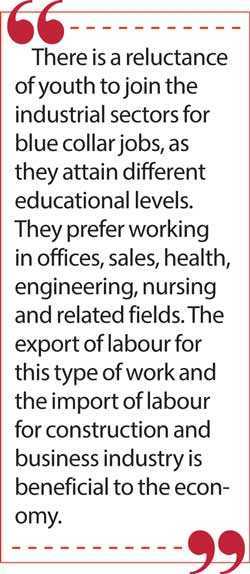Sunday Apr 20, 2025
Sunday Apr 20, 2025
Tuesday, 29 September 2020 00:54 - - {{hitsCtrl.values.hits}}

There is a severe shortage of skilled labour for industry and services. This is mainly to be seen in the construction, manufacturing, and hotel and tourist sectors. Even though this situation eased somewhat post COVID-19, it exists long-term – Pic by Shehan Gunasekara

In the economies of many developed countries, the main component in their economic development is human capital investment. Labour economists such as Minser and Baker explain that investments in general education, higher education, vocational training, expenditure in sports and health, could be considered human capital investment. The main aim of education is to produce individuals able to live independently and the aim of higher education and vocational training is to develop people in the competencies needed in the world.

Of the 2020 population of 24 million, half are not in the labour force and 25% out of the labour force are unskilled. The diagram gives important data in unskilled workforce.
In his policy document “Vistas of Prosperity and Splendour”, President Gotabaya Rajapaksa envisages a 20% reduction in the unskilled labour force in 2022, and a further 10% reduction by 2030, in order to create global technocrats and position Sri Lanka as the epicentre for human resource development in Asia. This emphasis shows the value of a skilled labour force. He has named the next 10 years “The Decade of Skills Development” in Sri Lanka, because he has realised the value of human capital.
We see skilled labour earnings are significantly higher than that of unskilled. In speaking of skilled labour, it is necessary to speak of the labour market which currently faces several problems. A principal problem is that while 350,000 students enter the school system, only 30,000 are absorbed into universities (8.5%). Even though 160,000 trainees enter the available vocational training institutes, only 70,000 obtain the NVQ certificate (2018). After some join private universities and professional institutes, about 150,000 join the labour force as unskilled workers. It is the responsibility of vocational institutes to train these people on behalf of the Government.
On the other hand, there is a severe shortage of skilled labour for industry and services. This is mainly to be seen in the construction, manufacturing, and hotel and tourist sectors. Even though this situation eased somewhat post COVID-19, it exists long-term. While the private sector is attempting to bring in migrant workers, it is assumed that about 200,000 workers have already come into the country without proper employment visa procedures. Since there are no proper procedures or policies about migrant workers yet, it is difficult to obtain data about them.
14% of the workforce, or around one million, are three-wheel drivers. While they have some level of education, this sector is considered as under employed. Another long-term problem is that females have distanced themselves from the workforce. Female participation in the workforce is only 36%. Moreover 350,000 capable youth have not joined the workforce. Thus, while there is a shortage of human resources, existing unemployment adds to the problems of the country’s goal of development. In addition, we can also see that the base of the population pyramid is narrowing while the apex is widening. In 2015, the percentage of those over 65 was 9.4%, but by 2045, this would be 21% (DCS, 2019)
Reduce unskilled personnel
There are 3 categories to be focused on to reduce unskilled personnel.
1.As of now, the number of unskilled in various occupations number 1,835,000
2.Those unskilled and waiting for employment number 265000
3.The number entering the education system annually is 350,000
The total of the first two categories who enter the labour market as unskilled is 2,100,000.This is 25% of the labour force.
Lowering the unskilled labour force by 10%
To enable this, there are 4 education and training systems available.
1.The schools education system (compulsory education for 13 years with tech subjects)
2.Higher education system (Universities and higher educational institutes)
3.Technical education and vocational training institutes (the Government and private training institutes under the Ministry of Skills Development; TVEC, VTA, NAITA, DTET, NYSC, CGTTI)
4.Professional development organisations (CIMA, CMA, ICA, AAT, CPM, NIBM, etc.)
These institutions would assist in competency development of the workforce in four different ways. Analysing the methodology of each sector would add meaning to the term “Decade of Skill Development”.
 |
 |
 |
Schools education system
The schools system lays the foundation for a just society and a skilled workforce. However there are several hindrances in the path of the system. Among them are:
1.In an exam driven system, there is no suitable place for soft skills
2.A lower emphasis on talent and innovation
3.Students being misguided because there is no strong career guidance program
4.Shortage of teachers to teach subjects such as English, Maths, Science, and Technology
5.Thirteen years of compulsory education is limited to only 212 schools
6.School education and vocational training sectors do not blend
Higher education and professional development
Higher education is important in developing a country’s workforce. However, the system is unable to perform sufficiently well, owing to several factors.
1.Only 19% of the students who sit the A/Levels are able to enter university
2.Most University entrants choose the Arts or Commerce streams, the syllabuses of which do not mirror global changes
3.The 0.33% allocated to higher education is insufficient. Also, the available physical resources are not used optimally.
4.Many students go overseas for study. There are no plans to capture them for local courses, nor are there plans to attract foreign students.
While these issues are there in the higher education system, there are other issues with regard to professional qualification providers. They create a surplus of accounting and management professionals. Further, there is no regulatory body to monitor them. Thus there are no statistics about them, which may lead to an oversupply.
Technical education and vocational training (TEVT)
A country must have a skilled workforce of varied capability to produce goods and services. The main player in this is the technical education and vocational training institutes, of which there are several in the country. It is heartening that the national qualification framework is compatible with international qualifications, and this enables our students to be internationally accepted. They are thus able to compete locally as well as internationally. Those who are unable to enter university can enter technical colleges and universities through the NVQ. There are over 1000 registered private and State training centres, which have an intake of 215,000 trainees. However, only around 70,000 of this was certified.
Main issues in the sector
The major is issue is an inability to train the labour force in keeping with the changes in the labour market. Moreover, the support given to services proponents is inadequate. In addition, the following inadequacies are present.
Career guidance
The technical education and vocational training sector attempts to establish career guidance. But the foundation to this should be laid in the schools. Students must be directed in their proper channels at secondary education level. But because there is no guidance, students choose paths not suitable to their ability. When they are unable to pursue the line of choice, they leave. This is a phenomenon prevalent internationally. Roughly, the percentage of these drop-outs is 15-20%.
Resource allocation
Even though this area is an area of economic development, the Government allocation is only around 0.2%. This negatively impacts the quality and the quantity of training.
Employment
A recent World Bank survey shows that the employability of Sri Lankan vocationally trained persons have an employability rate of 51%, lower than that of Bangladesh, Bhutan, or Nepal. However, those who train at the German Training Institute have a 98% employability, and the courses are also popular. Employability is reduced because:
Overcoming challenges to make the “Decade of Skills Development” successful
If the “Skills Decade” is to be successful, the country’s human resources must be more productive. For this to happen, all education providers – the schools, universities, and vocational training institutes –must address the issues they are faced with, and develop the labour force.
First, there should be established a think-tank in these places, and the institutional system has to be changed. General and university education and vocational training must be brought under one Ministry.
Schools education
The schools system is beset with many problems. Solving them would enable achieving a good labour force.
Furthermore:
1.The schools education should change with the changing economic and technological changes
2.Priority should be given to the foundation of a good labour force and for soft skills development
3.Career guidance in schools should be strengthened, as there is an urgent need for school-based career guidance policies.
4.Make available trained teachers for Mathematics, Science, English, and Technology
5.Compulsory competency-based education instead of 13 year mandatory education
6.Links between school education and vocational institutes should be strengthened
Higher education and other professional education
In order to build the labour force, university admissions must increase from 19% to 30%. It is not for traditional courses that candidates should be admitted, but for modern futuristic ones. Available resources should be made use of, new courses should be introduced, Arts subjects should be limited, and these new courses should incorporate new international trends. We should be able to attract foreign students and attempt to make Sri Lanka the education hub of Asia.
A regulatory body for other professional education is necessary. Instead of supplying labour for the areas which show a surplus, labour should be diverted to new areas, and to areas which show a shortage.
Technical education and vocational training
Identifying new trends in the national and international markets
The world labour market is continually changing. New jobs enter while old jobs exit. For instance, even though there was a demand for computer operators in the past, now there is no demand for them. Now operating a computer is only an additional skill for most jobs. Because of software, many jobs in the accounting field are becoming redundant. In most countries, ageing is increasing, and so jobs in the health sector are increasing. With the development of technology, artificial intelligence is increasingly used, making jobs obsolete.
Vocational training organisations have the responsibility of making youth aware of these changes. They have to be aware of the high-demand jobs. Analyses of the labour market show that jobs in solar power, wind power, and the health sector are growing fast. (Bureau of Labour Statistics, Employment Projections 2016-2026)
Influence from international success
In comparison to other Asian countries, our TEVT system has improved significantly. The main factors for this are widening the institutional framework, the introduction of the NVQ system, improving standards, and the widening of syllabuses. Yet in comparison with the neighbouring Singapore, Malaysia and Korea, we need to do more for improvement. For instance, the labour intensive economy of Singapore of 1960 evolved through six stages to the current status.
There is need for a wide plan of activity to face challenges. For this to happen the Government, the youth, parents, and those with social prejudices need to come together. The following proposals will be necessary to bring about a firm solution.
Strategies to change attitudes in society
The carpenter, mason attitude must change. In most developed countries, the social acceptance differences between occupations is very narrow. Everyone is accepted equally. These differences cannot be eliminated only by changing the name of the occupation.
Comparative advantage from the international labour market
There is a reluctance of youth to join the industrial sectors for blue collar jobs, as they attain different educational levels. They prefer working in offices, sales, health, engineering, nursing and related fields. The export of labour for this type of work and the import of labour for construction and business industry is beneficial to the economy. An authority needs to be established to oversee the areas where there is a shortage of labour, assist obtaining work permits, and for maintenance of data. This will prevent the arrival of unauthorised immigrants while being a source of income.
Further, in order to make the “Decade of Skills Development” successful, all institutions - educational and vocational training, and policy making bodies – must work in unison. The national objective is to reach per capita income of $ 12,000. A skilled workforce will be the backbone to achieve this target in the near future. In some countries, a Ministry of Human Resources has been established, which includes all relevant educational and vocational training organisations. The current Government has already taken step in this purpose by establishing the Ministry of Education. This is something that could be done in our country too, in order to have a strong skilled workforce.
The writer is Director, National Human Resources Development Council of Sri Lanka, Ministry of Public Services, Provincial Councils and Local Government